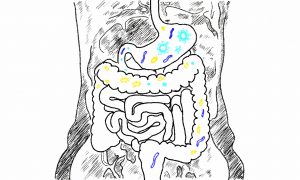Trending
pro·bi·o·tics (n.): The healthier side of germs
September, 2016

North Americans have been on germ warfare, annihilating the “-little critters” with every swipe, spray and pump of anti-bacterial cleansers available. But did you know that -probiotics are bacteria? And that there are trillions of them within our -bodies, many of which play an important role in our health? Researchers do, and they are wondering if all this ultra-cleansing of our bodies is doing more harm than good. To find out, they’re studying the role of probiotics. Here’s a small glimpse at what’s known.
I Have a Gut Feeling
Back in the 1600s, thanks to a new-fangled instrument called a microscope, researchers discovered that we have microbes inside us—bacteria being one type, and probiotics being one type of bacteria. The majority of those probiotics live in our intestines where they act like wardens, keeping watch over potentially harmful bacteria, such as Candida albicans (which can cause yeast infections) and Klebsiella (which can cause bacterial pneumonia).
The two most well-known and beneficial probiotics are Lactobacillus and Bifidobacterium. Lactobacillus is found in fermented dairy products (a.k.a. cultured dairy products) and produces both vitamin K and lactase (an enzyme that helps break down lactose). Bifidobacterium is found in some yogourts and has been used to help combat traveller’s diarrhea. Yet where do all these probiotics come from? Well, remember your appendix? It may not be so extraneous after all. Researchers have discovered that a bulk of the body’s probiotics are housed there.
In Europe, the concept of consuming probiotics is nothing new. So why have North Americans been so slow to adopt the idea? Simple. We’re afraid of bacteria. From antibiotics to cleaners claiming to kill 99.9% of germs, we’ve been attacking all things loosely related to bacteria for decades. And in that effort to kill diseases and stay healthy, we’ve been wiping out probiotics, too.
Penicillin & Germs
When penicillin was discovered in the late 1920s, it was considered a miracle drug because of the countless numbers of lives it saved, especially nearing the end of WWII. Recently, however, researchers have found that the overuse of penicillin and other antibiotics, combined with a diet high in processed food, has greatly reduced the number of probiotics in our bodies. In turn, that reduction has created an imbalance in our immune systems because probiotics keep the immune system in check by sending it chemical signals telling it not to overreact when harmless bacteria are inhaled or consumed. In fact, an allergy or intolerance to such things as pollen, nuts or bee stings is the immune system’s way of reacting to and attacking bacteria—sometimes to the point of threatening our lives. Now that doctors better understand the role of probiotics, they’re starting to prescribe patients a course of probiotics to help replenish these essential bacteria and, in turn, keep our immune systems in tip-top shape.
Probiotic’s Balanced Diet
Any nutrient source for probiotics is called a prebiotic. One source you may not know about is our own mucous; it contains sugar on which probiotics feed. Fibre is another source. Probiotics can digest it (harmful bacteria can-not) and make use of the nutrients to stimu-late its growth. Other sources of prebiotics are cranberries, carrots, pomegranates and oregano—apparently, one of the best prebiotics you can eat. Apart from yogourt, kimchi is also a popular source of probiotics. It’s a Korean fermented cabbage with vegetables such as radishes, red peppers and onions and is quite spicy. If spice, however, isn’t a part of your digestive life, try aged cheese, sauerkraut, brined pickles and Japanese miso, which is a fermented soybean paste.
Medical science worldwide is finding evidence that a healthy, balanced diet containing pre- and probiotics leads to a healthy balanced immune system. The key word there, however, is balanced. Understanding that most of the bacteria in and around us is harmless, even beneficial, will take us a step further in maintaining our health—one plate at a time. t8n
Did You Know
When the microbes within our bodies were first discovered, scientists believed they were looking at some form of microscopic plants. They called the microbes microflora, and scientists still use the term today.
Fun Fact
The combined weight of your kidneys, pancreas and heart (1.41 lbs) is lower than the weight of all the microbes in your body (3 lbs).
Microbes outnumber your own cells 10:1.
Over 99% of our intestinal microbes are bacteria of which there are 500 to 1000 different species.












